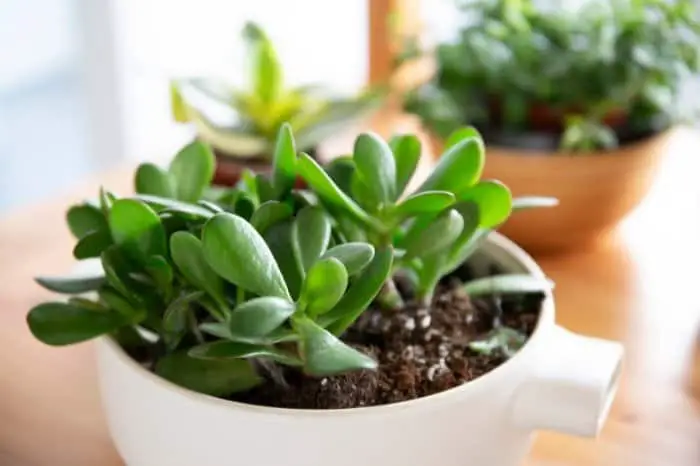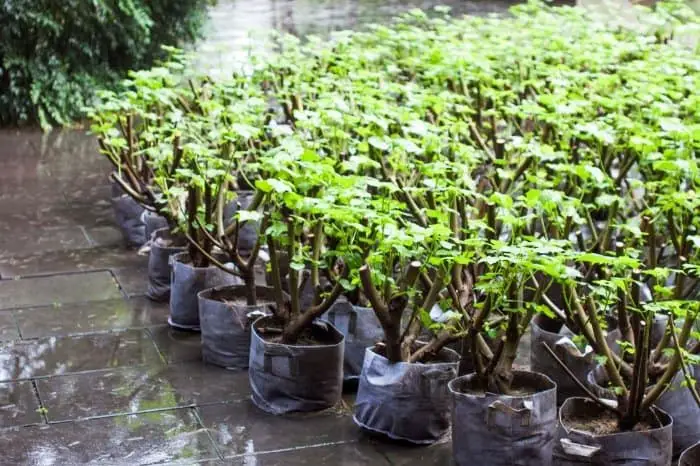Last Updated on October 29, 2022
Every plant requires proper drainage because it is critical to the health and growth of plants. When it comes to container gardening, a good drainage material for potted plants is super important. So, how do we ensure proper drainage in our container garden?
Good drainage in a container garden is essential because soil needs to drain properly so excess moisture won’t be trapped in the soil. Excess moisture can predispose your plants to root rot and oxygen will be depleted in the root areas.
You may have heard some common advice on making use of drainage material such as gravel, pebbles, rocks, and so on to help your potted plants. But is this really helpful in the drainage of your container garden? Well, let’s look into this.
What To Use For Drainage Material In Potted Plants
What to use for drainage in pots can significantly help your container plants flourish. There are several ways to providing the right drainage for plants and making use of drainage materials for potted plants is a good plan.
Most container or pot often comes with drainage holes and this is great. However, some pots don’t come in drainage holes. So if they don’t come in drainage holes, you need to ensure you provide your containers with proper drainage. You can as well create drainage holes in your pots or container by drilling the bottom.

However, there are some pots such as terra cotta or ceramic decorative pots that drainage holes can’t be made on. So making use of drainage materials can do the job.
All you need to do is to put other types of drainage materials at the bottom of your pot or container.
Let’s take a look at some drainage material that can be used for your potted plants.
Planter Drainage Material
So, here is some drainage material you can use for your potted plants:
1. Liner Pot
As we said, a pot that is decorative such as ceramic pots or terra cotta pots doesn’t usually come with drainage holes at its base. Therefore, we recommend you make use of a plastic planting container that already has the bottom drilled to ensure proper drainage.
The plastic container serves as a liner. Hence, it should be lined inside the larger pot. This way, it won’t be noticeable from the outside. So, you can always maintain your decorative pot at the same time provide proper drainage for your potted plants.
Be sure to always monitor the water level that drains into the bottom of the larger pot. Then discard the water at the base when it passes a few inches.

2. Coffee Filters
Most time, when watering your potted plants, you may experience some part of the soil washing out from the drainage holes. This is one major challenge faced in container gardening especially when the soil is loose soil like sandy soil.
But with the help of drainage materials such as coffee filters lined between the drainage holes of the pot and the soil, your soil can be kept tidy. It will allow for proper drainage while keeping your soil from escaping to the bottom of the pot whenever you water your plants.
Another filter similar to a coffee filter is a sheet of cheesecloth. So if coffee filters aren’t available, you can simply make use of a sheet of cheesecloth.
3. Perlite
Perlite is a good draining material that can be used in potted plants. Plants such as succulents and other plants sensitive to moisture can gain from perlite addition to potting soil.
Perlite tends to trap air by creating air pockets in the soil. This allows the soil to remain loose thereby draining moisture efficiently. Therefore, your potted plants won’t be sitting in a damp soil.
Organic Perlite by Perfect Plants — For Drainage Management and Enhanced Growth
Myths On Drainage Material Such As Gravel & Rocks
There has been some common suggestion or garden myth of using materials such as gravel, pebbles, rocks, and on can be used for drainage in potted plants. However, this has been debunked by experts.
Experts have claimed that water would be absorbed or collected by these gravels and rocks rather than drain them. So, water is made more difficult to move through the pot. Hence, this makes them not so good if you wish to achieve drainage in potted plants.
Simply using 1 inch of this rock or gravel can actually hinder or block the whole drainage hole. This ends up creating a waterlogged pot that can lead to root rot which will be bad for your plants. Additionally, the more rough or coarse the material used as drainage for potted plants, the worse the drainage.
Also, these kinds of materials usually occupy more space in the pot that was meant for the plant root. Therefore, we recommend you avoid these types of materials when it comes to drainage for your potted plants.
However, if you wish to improve water retention, you can make use of these materials. For instance, putting a couple of gravel underneath a liner pot can lessen the stress of frequently pouring out drained water. They can also serve as a barrier to the washing of soil.
FAQ’s
What can I use for drainage in potted plants?
You could try the following:
• Drainage mats. They are available at nurseries and home centers. You'll need two of these for each pot. Place the mat on the bottom of the pot, place the plant on top of it, and cover the plant with soil. This should keep water from sitting in the pot and allowing roots to rot. • Soak an old dishcloth in water and place it over the top of the pot. This will allow water to drain through the cloth and keep it from sitting in the pot. • Place the pot in a sink or bathtub with holes in the bottom. Water will run down through the bottom of the pot and into the tub.
What do you put in the bottom of an outdoor planter for drainage?
I would recommend putting down a layer of gravel. Then fill with a mix of equal parts peat moss, perlite, and sand. Cover that with a layer of mulch. The mulch will hold moisture and keep the plant roots from sitting on the peat moss and possibly rotting it.
Should you put rocks in bottom of planter?
You can put rocks in the bottom, but I'd recommend using sand or something with a lot of air space in it.
How do you give drainage to indoor plants?
Indoor drainage is a very important part of maintaining a healthy indoor environment for plants. It’s easy to overlook this part of your plant care, but if you don’t have proper drainage in your growing room, you can end up with a wet, moldy mess that will be difficult to remove.
Drainage is the process of removing water from your indoor garden. It may seem like an obvious concept, but it’s important to know what kind of drainage system you need in order to maintain a healthy environment for your plants.There are a few options. The easiest would be to put a layer of gravel on top of your potting mix, and then place the plant directly into the gravel. You can also use a tray with holes in it that allows water to drain from the potting mix down into the tray. You could put some plastic under the potting mix, then place the plant in the plastic.
There are also pots made specifically for growing plants that have drainage holes. For example, the Pot Plant has holes all around the rim of the pot. The roots will grow through the holes, and water will drain away. This is a great way to grow plants that need to stay in a small space. If you want to be more creative, you can make your own drainage system. You can use a coffee can or plastic tub, and then drill holes in the bottom. You could also put a hole in the bottom of a pot. You would just have to fill it with a small amount of gravel, then plant your plant.
Conclusion On Drainage Material For Potted Plants
One of the most crucial aspects of container gardening is drainage. Improper drainage in container gardening can cause your plant root to be waterlogged and cause root rot. It can even cause improper air circulation to your plant’s roots which will be bad for the growth of your plant.
We’ve listed some drainage material you can use for your potted plants. You can as well improve drainage by adding unobstructed holes at the base of your pot or container. Also, ensure you select the right container depending on the plant’s size. Then always water correctly.
Therefore, you need to ensure your container plants are well-draining. So, making use of drainage material for your potted plants is a great way to providing a proper flow of water and air circulation.

Eunice is an enthusiastic gardener with a passion for growing beautiful flowers. She loves nothing more than spending time in her garden, tending to her plants and enjoying the outdoors. Eunice has been gardening for over 15 years and has developed a unique style of landscaping that is both practical and aesthetically pleasing. She is especially fond of growing roses and enjoys experimenting with different varieties and colors. Eunice takes great pride in her garden and often shares the fruits of her labor with friends and family. In her spare time, she enjoys reading gardening magazines and attending local horticulture events. Eunice is passionate about her hobby and is always eager to share her knowledge and experience with others.

